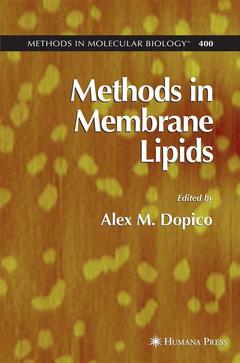A Glance at the Structural and Functional Diversity of Membrane Lipids.- Membrane Lipid Polymorphism.- Acrylodan-Labeled Intestinal Fatty Acid-Binding Protein to Measure Concentrations of Unbound Fatty Acids.- Measuring Molecular Order and Orientation Using Coherent Anti-Stokes Raman Scattering Microscopy.- Preparation of Oriented, Fully Hydrated Lipid Samples for Structure Determination Using X-Ray Scattering.- Nuclear Magnetic Resonance Investigation of Oriented Lipid Membranes.- Molecular Dynamics Simulations as a Complement to Nuclear Magnetic Resonance and X-Ray Diffraction Measurements.- Use of Inverse Theory Algorithms in the Analysis of Biomembrane NMR Data.- Statistical Thermodynamics Through Computer Simulation to Characterize Phospholipid Interactions in Membranes.- Fluorometric Assay for Detection of Sterol Oxidation in Liposomal Membranes.- Fluorescence Detection of Signs of Sterol Superlattice Formation in Lipid Membranes.- Differential Scanning Calorimetry in the Study of Lipid Phase Transitions in Model and Biological Membranes.- Pressure Perturbation Calorimetry.- Fourier Transform Infrared Spectroscopy in the Study of Lipid Phase Transitions in Model and Biological Membranes.- Optical Dynamometry to Study Phase Transitions in Lipid Membranes.- Fluorescence Assays for Measuring Fatty Acid Binding and Transport Through Membranes.- Measurement of Lateral Diffusion Rates in Membranes by Pulsed Magnetic Field Gradient, Magic Angle Spinning-Proton Nuclear Magnetic Resonance.- Using Fluorescence Recovery After Photobleaching to Measure Lipid Diffusion in Membranes.- Single-Molecule Fluorescence Microscopy to Determine Phospholipid Lateral Diffusion.- Modeling 2D and 3D Diffusion.- Measurement of Water and Solute Permeability by Stopped-Flow Fluorimetry.- Fluorescence Microscopy to Study Pressure Between Lipids in Giant Unilamellar Vesicles.- X-Ray Scattering and Solid-State Deuterium Nuclear Magnetic Resonance Probes of Structural Fluctuations in Lipid Membranes.- Determination of Lipid Spontaneous Curvature From X-Ray Examinations of Inverted Hexagonal Phases.- Shape Analysis of Giant Vesicles With Fluid Phase Coexistence by Laser Scanning Microscopy to Determine Curvature, Bending Elasticity, and Line Tension.- Laser Tweezer Deformation of Giant Unilamellar Vesicles.- Measurement of Lipid Forces by X-Ray Diffraction and Osmotic Stress.- Micropipet Aspiration for Measuring Elastic Properties of Lipid Bilayers.- Langmuir Films to Determine Lateral Surface Pressure on Lipid Segregation.- Detergent and Detergent-Free Methods to Define Lipid Rafts and Caveolae.- Near-Field Scanning Optical Microscopy to Identify Membrane Microdomains.- Fluorescence Microscopy to Study Domains in Supported Lipid Bilayers.- Fluorescence Resonance Energy Transfer to Characterize Cholesterol-Induced Domains.- Lipid Domains in Supported Lipid Bilayer for Atomic Force Microscopy.- Nuclear Magnetic Resonance Structural Studies of Membrane Proteins in Micelles and Bilayers.- Laurdan Studies of Membrane Lipid-Nicotinic Acetylcholine Receptor Protein Interactions.- Single-Molecule Methods for Monitoring Changes in Bilayer Elastic Properties.- Ion-Channel Reconstitution.- The Use of Differential Scanning Calorimetry to Study Drug-Membrane Interactions.- Atomic Force Microscopy to Study Interacting Forces in Phospholipid Bilayers Containing General Anesthetics.




